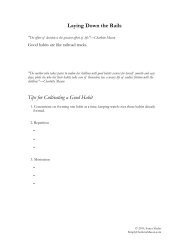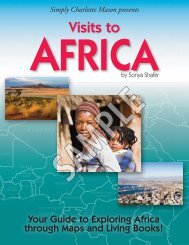book - Simply Charlotte Mason
book - Simply Charlotte Mason
book - Simply Charlotte Mason
Create successful ePaper yourself
Turn your PDF publications into a flip-book with our unique Google optimized e-Paper software.
and mummies, golden masks and mysterious hieroglyphic<br />
writing. But before all of those things came to be, Egypt was<br />
a land of villages, strung along the river like beads on a wide<br />
green ribbon, waiting for the annual appearance of the star<br />
Sopdet.<br />
The life-giving Nile is the longest river in the world. It<br />
arises in the blue waters of Lake Victoria, far to the south<br />
in the modern-day countries of Uganda and Rwanda. From<br />
there it meanders northward until it is joined by another river,<br />
the Blue Nile, near the great city of Khartoum in the nation<br />
of Sudan. Much larger now, it flows ever northward, through<br />
six great cataracts, which is a word for whitewater rapids—<br />
places where the water is broken by many boulders and stones<br />
and tiny islands, so that it curls and foams. After its wild and<br />
rushing passage through the cataracts, the Nile calms itself<br />
and flows smoothly onward through the land of Egypt until it<br />
reaches the low lands bordering the Mediterranean Sea. There<br />
it begins to divide and braid, spreading out into many streams<br />
that together form a great delta, a triangular shaped mass<br />
of green reeds and water channels, through which the river<br />
eventually drains into the Sea. If you will look at a map of<br />
Egypt, you will see the Nile Delta at its northern edge, shaped<br />
very much like a lotus flower, with the verdant banks of the<br />
flowing river stretching south like a graceful stem.<br />
There were perhaps a million people living in the little<br />
villages, at the dawn of Egypt’s history. They nestled close<br />
to the river, the source of life. Beyond its reach, the Sahara<br />
desert was ever present, thousands of miles of arid sand. The<br />
Egyptians, the people of the Black Land, called the desert<br />
Deshret (DESH-ret), the Red Land; and they feared its power.<br />
It was the dead land, the barren land, and only the power of<br />
the river kept it at bay. If the river were ever to fail, the dry red<br />
desert would creep in and cover their villages and fields with<br />
endless drifting sand.<br />
<strong>Simply</strong><strong>Charlotte</strong><strong>Mason</strong>.com 7

















